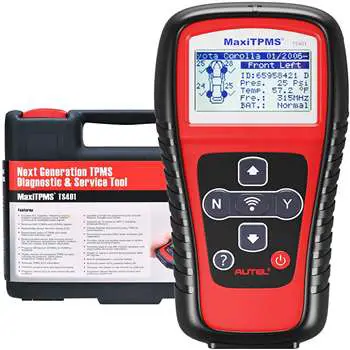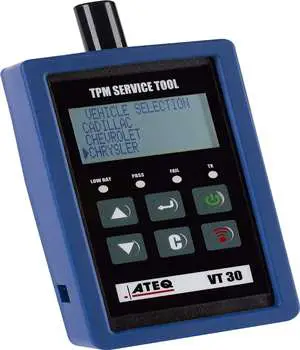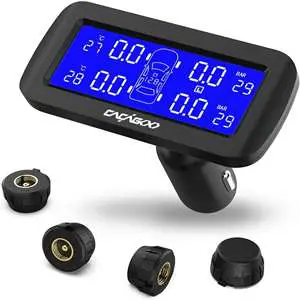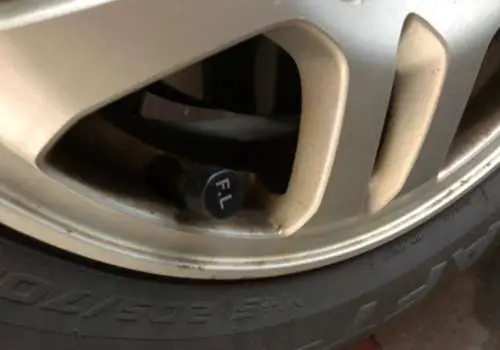
How to Tell Which TPMS Sensor is Bad?
TPMS (Tire Pressure Monitoring System) is a preinstalled system in modern cars that monitors your vehicle’s tires’ pressure.
It computes the air pressure in your vehicle’s tires and alarms you if the air pressure is abnormal.
If tpms sensor reading wrong pressure, then finding a faulty tpms sensor is not a big deal. You can adapt the following methods to find faulty tpms sensor:
Car Display Panel
Firstly, you need to look for a tire pressure sensor fault on the dashboard display panel.
If you notice the tire pressure light blinking, it is an indication of some fault in TPMS. The ECU or PCM, which gets all the sensors’ data, triggers an admonition on your dashboard, demonstrating that something isn’t right with the sensors.
For example, a tire pressure sensor is not working as per the norm; the tpms sensor light will be on.
Hence, you will receive a notification on your very dashboard display panel about the fault in the TPMS.
TPMS Diagnostic Tool / TPMS Reader
TPMS scan tool helps identify all sorts of faults in a TPMS sensor, including a drained battery, a failed voltage supply or wiring problem, etc.
Most vehicles have a tire pressure sensor relearn mode or retrain mode, which means that the sensor sends signals to the tool if air comes in or goes out of the tire.
The signal is what initiates a horn chirp, which is an indication of a healthy sensor. If you don’t hear a squeak, the sensor is faulty.
Before getting your hands onto the TPMS tool, check the tires’ air pressure. You can also confirm the sensor’s reading by checking the tire’s real pressure with a pressure gauge.
Filling and Releasing of Air
This process is a bit tedious, but it’ll get you to identify the problem. All you need to do is fill up all four tires up to the recommended pressure.
Gently release air from the tires one after the other and check the car display panel. The tire(s) that does not send the message has a defect and needs replacement.
Once you have identified the problem, mark the wheel(s) and make sure to refill the tires with adequate air.
Using a Digital Pressure Gauge
Using a pressure gauge is a good idea, too, if you are looking for a faulty TPMS sensor. Measure the air pressure in all the tires and note the reading.
Compare the gauge’s readings to the one shown on the display panel. If there is a difference in reading of any sensor, then it is faulty one,
A Tire pressure gauge is quite a handy piece of equipment so having one is a smart idea. See the latest price here.
How to Tell which TMPS Sensor is Bad?
Fill all tires with recommended air pressure. Now, you need to release air from each tire, one after another. Keep noticing the display panel for any message. You will observe that the tire, which does not display correct pressure or out-of-range message to the car display panel, depicts a faulty sensor.
This is one of the easiest methods of checking which tire pressure sensor is bad. You can mark the tire with a faulty sensor and get it to replace it while refilling the tires, which are at no fault.
How to Tell which Tire Pressure Sensor is Bad?
The quick and easiest way to know which tire pressure sensor is bad is by using a pressure gauge. This tool can help in determining the tire pressure.
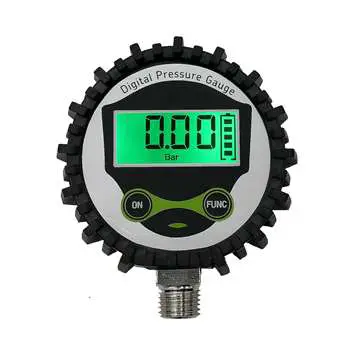
Thus, you need to verify the final reading from the gauge with the pressure shown in the TMPS display panel. If the pressure matches, the sensor is all good. However, if there exists a discrepancy in the reading, it signifies the particular tire sensor as a faulty one. See the latest price here.
Bad Tire Sensor Symptoms / Bad TPMS Sensor Symptoms
There are some quite noticeable changes in the vehicle when a TPMS sensor goes bad. It can be due to dirt, dust, heat, etc. that can lead to it malfunctioning.
Here are some of the most common symptoms of a bad tire sensor system:
- TPMS warning light
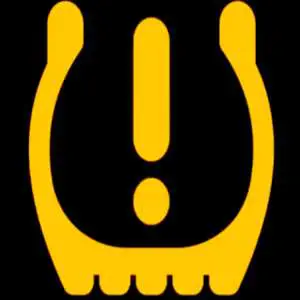
A small light illuminates at the dashboard’s display panel whenever there is a problem with the tire pressure sensors.
It appears as a vivid yellow exclamation point inside of a U symbol; you’d be easily able to spot it. As soon as it turns on, the driver must check the tire for less or no air.
- Jerky Steering Wheel
When the vehicle’s front tires are low on the air pressure, the tires’ sides become softer, which makes it hard for the driver to keep the steering wheel steady and straight.
Therefore, an underinflated tire can result in a jerky steering wheel, jolting left and right even when trying to keep it straight.
- Fuel Consumption
When a tire goes flat, the friction between the ground and the tires increases, which requires higher traction to move.
As the engine burns more fuel to make up for that power requirement, the fuel consumption increases up to a great extent, which would be pretty noticeable.
- ABS Light on the dashboard illuminates
The indirect tire pressure monitoring system enables the wheel speed sensor to monitor the ABS (anti-lock braking system).
ABS keeps the wheels of the vehicles from locking up and makes sure they keep a good grip on the road.
However, it is common for anti-lock braking systems to light up when a sensor becomes faulty or has a bad connection.
Why is My Tire Pressure Light on when my Tires are Fine?
There might be many possible reasons for this concern. It may be because your TMPS needs a reset. Moreover, this might also happen because of dead sensor batteries or a poor signal receiver.
If you have recently fueled up a tire with air, you might need to run a few miles to resolve this issue.
What to do if TPMS light but Tire Pressure Good?
I frequently see people dealing with tire pressure light keeps coming on even when their vehicles’ tires have the right amount of air pressure.
This problem might occur due to the following reasons:
- The batteries that power TPMS sensors have a life expectancy of 6 to 10 years. A failing battery can be the culprit.
- A faulty receiver with an inner flaw or a short out, the sign will fall flat and will fail to communicate with the dashboard.
- Defective display panel
- if the TPMS not reading any tires, you haven’t reset the TPMS after changing or rotating the tires.
- Cold weather can also compress the air, which messes up the reading.
You might want to give the sensor at least 3-4 miles after filling the tires with air to receive the signal and show a reading.
How to Check TMPS Sensor?
In order to check the TMPS sensor, you would need to shift the car to program mode. Hold and press the TMPS tester button but make sure to keep it near to the sensor. If your car chirp at the press of the button, it shows that the tire sensor is fine. However, if it doesn’t chirp, then it signifies a faulty tire sensor.
Furthermore, with the help of the same tester, you can test the TMPS sensor’s battery life as well. Click Here to Buy an Autel TPMS Relearn Tool now.
How to Prevent TPMS Sensor Broken During Tire Change?
Has it ever happened that you were changing a tire and end up damaging the TPMS sensor? Relax; it happens to a lot of us.
It happens because the run of the equipment used to both mount and descent a tire to the wheel was, deplorably, not planned considering TPMS.
Here are some steps that’ll help you remove or change the tire without damaging the TPMS sensor:
- Use the aluminum clamp-in stem to remove the nut from the stem and wait until the sensor has fallen into the tire. It’s the easiest way to save the sensor from damage.
- For a rubber snap-in stem, keep the valve at a 6:00 or 12:00 position while breaking the bed for front and back tires. It prevents the machinery from crushing the sensor.
- While removing the tire and starting the turntables, keep the valve below the dismount head when working with a rubber snap-in stem. It prevents the tire from hitting the valve and hence, protecting the sensor.
How to tell which TPMS Sensor is Bad Ford/ Toyota / Honda?
Regardless of what vehicle you own, a TPMS reader is the easiest way to detect a faulty TPMS sensor. Switch your vehicle into program mode.
Hold and press the TPMS tester button near the sensor and wait for the chirping sound. If you hear the squeak, the sensor is fine, but if there is no sound whatsoever, there is a faulty sensor.
To test the TPMS sensor’s battery life, you can use the ATEQ VT30 Universal TPMS Activation and TPMS Reset Tool.
This same handheld device is straightforward to use and works perfectly for almost all vehicles. It makes the process of resetting the TPMS by activating the sensors.
Another great thing about this tool is that it displays useful sensor information like sensor ID, battery frequency, temperature, tire pressure, etc. See the latest price here.
What is Tire Pressure Sensor Replacement Cost?
TPMS Replacement Cost
The tire sensor replacement costs depend on the type of vehicle you own. It includes the model of the car and the kind of tire pressure sensor used in it.
It starts from around $80 and can go up to $250 to replace a faulty TPMS sensor.
Recommendation: Tire Pressure Monitoring System
If you are thinking about adding tpms to older car or a car that don’t have one, then here is a universal tpms sensor kit which fits almost every vehicle
CACAGOO Wireless TPMS Tire Pressure Monitoring System with 4pcs External Sensors (0-8.0 Bar/ 0-116 Psi)
Providing simultaneous monitoring to all tires gives the first admonition of air releases and other strange tire conditions so that you can take remedial measures.
An effective CR1632 battery fuels the wireless sensors, and the screen connects to the cigarette lighter.
The wide-calculated screen makes it simple to peruse from any point day or night. No sweat of discernible and noticeable alarms, the gadget substantiates itself very helpful.
The sensor on each tire is IP67 evaluated, which means it is fixed against any accumulation and keeps up good performance regardless of the roads’ condition. See the latest price here.

